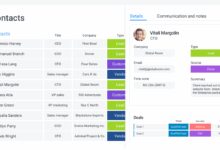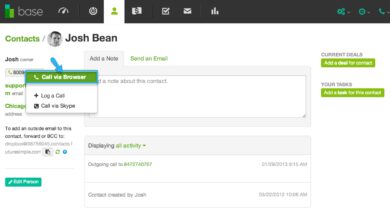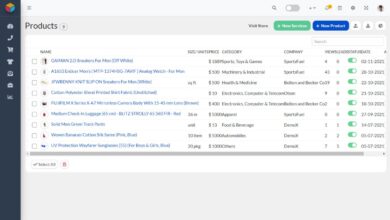CRM Base de Donnee: 7 Power Secrets to Master Your Database
In today’s fast-paced digital world, a crm base de donnee isn’t just a tool—it’s your business’s beating heart. It stores every customer interaction, tracks sales trends, and fuels smarter decisions. Let’s dive into how to harness its full power.
What Is a CRM Base de Donnee? (And Why It Matters)
A crm base de donnee is the structured collection of customer information managed within a Customer Relationship Management (CRM) system. It goes beyond simple contact lists—it captures interactions, purchase history, preferences, support tickets, and behavioral data, all centralized for easy access and analysis.
The Core Components of a CRM Database
Understanding the anatomy of a crm base de donnee helps businesses optimize its use. Key components include:
- Customer Profiles: Names, contact details, job titles, company affiliations.
- Interaction History: Emails, calls, meetings, social media engagements.
- Sales Pipeline Data: Deal stages, expected close dates, value forecasts.
- Support Tickets: Customer service logs, resolution times, agent notes.
- Behavioral Analytics: Website visits, email open rates, product usage patterns.
These elements work together to create a 360-degree view of each customer, enabling personalized engagement and proactive service.
How CRM Databases Differ from Traditional Spreadsheets
While spreadsheets like Excel might seem like a low-cost alternative, a crm base de donnee offers dynamic, real-time collaboration and automation. Unlike static files, CRM databases:
- Update in real time across teams.
- Support workflow automation (e.g., follow-up emails).
- Integrate with marketing, sales, and support tools.
- Offer role-based access control for security.
For example, Salesforce’s CRM platform processes over 1.4 billion transactions daily, a scale impossible with manual spreadsheets.
“A CRM database turns raw data into relationships. It’s not about storing names—it’s about understanding needs.” — Gartner Research
7 Key Benefits of a Well-Managed CRM Base de Donnee
Leveraging a crm base de donnee effectively can transform how your organization interacts with customers. Here are seven powerful advantages:
1. Enhanced Customer Personalization
With a centralized crm base de donnee, businesses can tailor communications based on past behavior and preferences. For instance, an e-commerce company can send personalized product recommendations after analyzing previous purchases and browsing history.
According to a McKinsey study, personalized marketing can deliver five to eight times the ROI of traditional campaigns and lift sales by 10% or more.
2. Improved Sales Efficiency
Sales teams spend nearly 34% of their time on non-selling tasks. A robust CRM database automates data entry, lead scoring, and follow-ups, freeing reps to focus on closing deals.
Automated workflows can trigger tasks when a lead opens an email or visits a pricing page, ensuring timely engagement without manual tracking.
3. Stronger Customer Retention
Retaining customers is up to five times cheaper than acquiring new ones. A crm base de donnee helps identify at-risk clients through engagement drops or support complaints, allowing preemptive outreach.
For example, a SaaS company might use churn prediction models based on login frequency and feature usage stored in the CRM.
4. Data-Driven Decision Making
Leaders gain real-time insights into performance metrics like conversion rates, average deal size, and customer lifetime value. Dashboards powered by the crm base de donnee enable executives to spot trends and adjust strategies quickly.
Tools like HubSpot and Zoho offer built-in analytics that visualize sales funnels and customer journeys directly from the database.
5. Seamless Team Collaboration
Departments like sales, marketing, and customer service often work in silos. A shared crm base de donnee breaks down these barriers, ensuring everyone accesses the same updated information.
When a support agent resolves an issue, the sales team can immediately see the update and adjust their approach—avoiding awkward follow-ups during service outages.
6. Scalability for Business Growth
As your customer base expands, managing relationships manually becomes unsustainable. A crm base de donnee scales with your business, supporting thousands of contacts, complex segmentation, and multi-channel engagement.
Cloud-based CRMs like Microsoft Dynamics 365 allow global teams to access the database securely from anywhere, making expansion smoother.
7. Regulatory Compliance and Data Security
With regulations like GDPR and CCPA, businesses must protect customer data. A professional crm base de donnee includes encryption, audit trails, and consent management features.
For instance, Salesforce offers Trust and Compliance Center tools that help organizations meet data protection standards automatically.
How to Build a High-Performance CRM Base de Donnee
Creating an effective crm base de donnee requires strategy, not just software. Follow these steps to build a database that drives results.
Step 1: Define Your Data Requirements
Start by identifying what data matters most to your business. Common fields include:
- Demographics (age, location, industry)
- Firmographics (company size, revenue, tech stack)
- Engagement metrics (email opens, webinar attendance)
- Lead source and campaign attribution
Custom fields can capture niche data—like a real estate CRM tracking property preferences or a healthcare provider logging patient consent forms.
Step 2: Choose the Right CRM Platform
Not all CRMs are created equal. Consider these factors:
- Scalability: Will it grow with your business?
- Integration: Does it connect with your email, calendar, and marketing tools?
- User-Friendliness: Can your team adopt it quickly?
- Cost: Is pricing aligned with your budget and ROI expectations?
Popular options include:
- Salesforce – Best for enterprise-level customization.
- HubSpot CRM – Ideal for startups and mid-sized businesses.
- Zoho CRM – Cost-effective with strong automation.
- Microsoft Dynamics 365 – Great for organizations already using Microsoft 365.
Step 3: Clean and Migrate Existing Data
If you’re switching from spreadsheets or legacy systems, data migration is critical. Poor data quality costs businesses an average of $15 million annually, according to IBM.
Best practices include:
- Deduplicating records before import.
- Standardizing formats (e.g., phone numbers, addresses).
- Validating email and contact information.
- Using ETL (Extract, Transform, Load) tools for smooth transfer.
Many CRM vendors offer data migration services or partner with third-party experts like Stitch or Fivetran.
Top Features to Look for in a CRM Base de Donnee System
A powerful crm base de donnee should do more than store data—it should activate it. Here are essential features to prioritize.
Automation and Workflow Management
Automate repetitive tasks like lead assignment, email follow-ups, and task reminders. For example, when a lead downloads a whitepaper, the CRM can automatically tag them, assign a sales rep, and send a welcome sequence.
HubSpot’s workflow automation has helped companies reduce manual effort by up to 60%, according to internal case studies.
AI-Powered Insights and Predictive Analytics
Modern CRMs use artificial intelligence to predict customer behavior. Salesforce’s Einstein AI, for instance, forecasts which leads are most likely to convert and recommends the best time to contact them.
These insights turn your crm base de donnee into a strategic asset, not just a storage system.
Mobile Accessibility
Sales teams on the go need real-time access. Mobile CRM apps allow reps to update records, view customer history, and log calls from the field.
According to Salesforce, 74% of sales professionals use mobile CRM daily, improving responsiveness and deal velocity.
Custom Reporting and Dashboards
Pre-built reports are helpful, but customizable dashboards let you track KPIs that matter to your business. Whether it’s monthly recurring revenue (MRR) or customer satisfaction (CSAT), visual dashboards make data digestible.
Tools like Zoho Analytics integrate directly with the CRM database for real-time reporting.
Third-Party Integrations
Your crm base de donnee should connect with other tools you use:
- Email platforms (Gmail, Outlook)
- Marketing automation (Mailchimp, ActiveCampaign)
- Customer support (Zendesk, Freshdesk)
- E-commerce (Shopify, WooCommerce)
- Accounting software (QuickBooks, Xero)
Integration platforms like Zapier or Workato enable seamless data flow between systems, reducing manual entry and errors.
Common Challenges with CRM Base de Donnee (And How to Solve Them)
Even the best CRM systems face adoption and operational hurdles. Here’s how to overcome them.
Challenge 1: Low User Adoption
Employees may resist using the CRM if it feels like extra work. A Nucleus Research report found that poor adoption is the top reason CRM projects fail.
Solutions:
- Involve users in the selection process.
- Provide hands-on training and ongoing support.
- Highlight personal benefits (e.g., easier task management).
- Set clear usage expectations and track compliance.
Challenge 2: Data Inaccuracy and Duplication
Duplicate or outdated records erode trust in the system. Imagine two sales reps contacting the same client minutes apart—unprofessional and frustrating.
Prevention strategies:
- Enable duplicate detection rules.
- Assign data ownership and accountability.
- Schedule regular data audits.
- Use validation rules (e.g., mandatory fields).
Challenge 3: Lack of Integration with Other Tools
If your CRM doesn’t talk to your email or marketing platform, data silos persist. This leads to inconsistent messaging and missed opportunities.
Fix it by:
- Choosing a CRM with native integrations.
- Using middleware like Zapier or Make (formerly Integromat).
- Working with IT or consultants to build custom APIs.
Challenge 4: Poor Data Governance
Without clear policies, anyone can edit, delete, or export sensitive data—posing security and compliance risks.
Establish governance by:
- Defining user roles and permissions.
- Logging all data changes (audit trails).
- Setting data retention and deletion policies.
- Conducting regular compliance reviews.
Best Practices for Maintaining a Healthy CRM Base de Donnee
A CRM database is not a “set it and forget it” tool. It requires ongoing care to remain accurate and valuable.
Regular Data Audits and Cleansing
Schedule quarterly or bi-annual data cleanups. Remove inactive leads, update job changes, and verify contact details. Tools like ValidEmail or Clearout can automate email validation.
Tip: Use segmentation to isolate high-value customers and prioritize their data accuracy.
Enforce Data Entry Standards
Create templates and required fields to ensure consistency. For example, mandate that all new leads include a source tag (e.g., “Webinar – June 2024”) so marketing can track campaign effectiveness.
Train teams on the importance of accurate input—garbage in, garbage out applies to CRMs too.
Leverage Automation to Reduce Manual Errors
Manual data entry is error-prone and time-consuming. Automate wherever possible:
- Sync calendar events to log meetings.
- Use web forms to capture leads directly into the CRM.
- Integrate with LinkedIn Sales Navigator for one-click profile imports.
Train and Re-Train Your Team
Onboarding is just the beginning. As CRM features evolve, so should your team’s knowledge. Host monthly “CRM tip” sessions or create a knowledge base with video tutorials.
Recognize and reward top CRM users to encourage engagement.
Monitor Key CRM Health Metrics
Track indicators like:
- Percentage of complete customer profiles.
- Number of duplicate records.
- Time between lead capture and first contact.
- User login frequency.
These metrics reveal how healthy your crm base de donnee truly is.
Future Trends Shaping the CRM Base de Donnee Landscape
The future of crm base de donnee is intelligent, predictive, and deeply integrated. Here’s what’s coming.
AI and Machine Learning Integration
AI will go beyond predictions to offer prescriptive insights—like recommending the next best action for a sales rep or auto-generating personalized email drafts.
Google’s Contact Center AI and Amazon Connect are already blending CRM data with conversational AI for smarter customer service.
Hyper-Personalization at Scale
With advanced segmentation and real-time data, businesses will deliver individualized experiences to thousands of customers simultaneously. Think dynamic website content, personalized pricing, and AI-driven product suggestions—all fueled by the crm base de donnee.
Increased Focus on Privacy and Consent Management
As regulations tighten, CRMs will need built-in consent tracking. Expect features like automated opt-in logs, preference centers, and data portability tools to become standard.
Platforms like Salesforce are already leading with Privacy Center dashboards.
Blockchain for Data Integrity
While still emerging, blockchain could enhance CRM databases by providing immutable logs of customer interactions, ensuring transparency and trust—especially in industries like finance and healthcare.
Voice-Activated CRM Interfaces
Imagine saying, “Log my call with John Doe and schedule a follow-up for Friday,” and your CRM does it automatically. Voice assistants integrated with CRM systems are becoming a reality through tools like Amazon Alexa for Salesforce.
Real-World Examples of CRM Base de Donnee Success
Theory is great, but results matter. Here are real companies leveraging their crm base de donnee for growth.
Example 1: HubSpot’s Inbound CRM Strategy
HubSpot built its entire business model around inbound marketing powered by CRM data. By tracking every visitor’s journey—from blog reads to demo requests—they nurture leads with precision.
Result: Over 150,000 customers and $1.5 billion in annual revenue (2023).
Example 2: Amazon’s Personalization Engine
While not a traditional CRM, Amazon’s customer database drives 35% of its sales through personalized recommendations. Every click, search, and purchase feeds into a massive crm base de donnee-like system.
Lesson: Data depth equals revenue depth.
Example 3: Salesforce with AI for Healthcare
Salesforce Health Cloud uses CRM databases to manage patient journeys. Clinics track appointments, treatments, and consent forms in one place, improving care coordination.
Outcome: 30% faster patient onboarding and higher satisfaction scores.
What is a crm base de donnee?
A crm base de donnee is a centralized database within a Customer Relationship Management (CRM) system that stores customer information, interaction history, sales data, and behavioral insights to improve relationship management and business decision-making.
Why is a CRM database important for sales teams?
A CRM database provides sales teams with real-time access to customer data, automates follow-ups, tracks deal progress, and enhances personalization, leading to higher conversion rates and shorter sales cycles.
How do I choose the right CRM for my business?
Consider factors like scalability, integration capabilities, ease of use, mobile access, and cost. Evaluate your team’s needs and start with a platform like HubSpot for simplicity or Salesforce for advanced customization.
Can a CRM base de donnee help with marketing automation?
Yes, a crm base de donnee integrates with marketing tools to enable automated email campaigns, lead scoring, behavior-based segmentation, and performance tracking across channels.
How often should I clean my CRM database?
It’s recommended to audit and clean your CRM database every 3 to 6 months to remove duplicates, update outdated information, and ensure data accuracy for reliable reporting and outreach.
Mastering your crm base de donnee is no longer optional—it’s essential for staying competitive. From boosting sales efficiency to enabling hyper-personalized marketing, a well-maintained CRM database acts as the central nervous system of your customer strategy. By choosing the right platform, enforcing data discipline, and embracing emerging technologies like AI, businesses can turn raw data into lasting relationships. The future belongs to those who don’t just collect data, but understand it, act on it, and evolve with it. Start building your powerful crm base de donnee today, and unlock the full potential of every customer interaction.
Further Reading:






